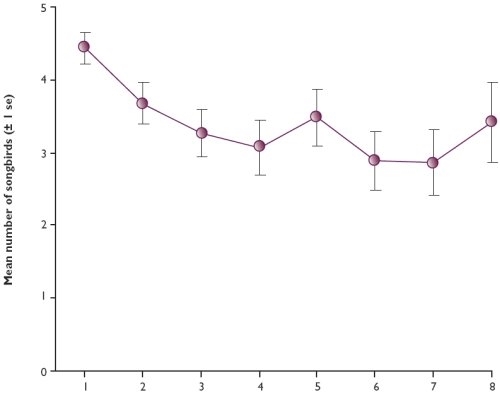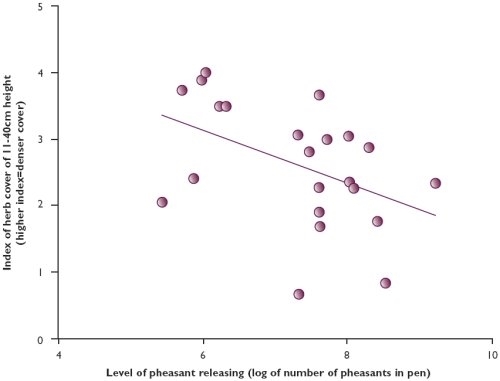Key findings
- Songbird numbers and diversity were highest along woodland edges nearest the release pen.
- Butterfly and bumblebee diversity and abundance did not vary with distance from the release pen.
- Woodland edges close to release pen had lower plant diversity than other woodland edges.
In 2002 we launched a three-year research project looking at the impacts of released pheasants on habitats and wildlife in the wider countryside, away from the release sites themselves. The main aim of this research was to look at relationships between the density of released pheasants and common wildlife indicators, such as plants, songbirds and butterflies. The fieldwork was carried out in 2002 and 2003 at over 100 different shooting estates in England, and in 2004 we pulled together the data collected.
The study encompassed sites releasing from a few hundred to over 50,000 pheasants, and we grouped these into four distinct regions or Natural Areas: the Wessex Downs, North Devon and Somerset, the East Anglian Plain and Bedfordshire area. At each site we defined eight sampling stations along a one-kilometre transect, starting at the edge of a wood containing a release pen and following field and wood edges away from the release site into the adjacent farmland to where few pheasants venture. At each station we measured hedgerow or wood-edge structure and plant diversity and songbird, butterfly and bumblebee diversity and abundance. We compared these measures with distance along the transect, and between sites (with numbers released).
In hedgerows there was no variation in either songbird abundance (individuals) or diversity (species) along transects, and the density of pheasant releasing between sites had no effect either. Hedgerows in the Wessex Downs region had more songbirds than in the other three areas. For woodland edges we found there were more songbird individuals and species along those closest to the pen (see Figure 1). This may reflect the fact that the pen is often sited in the largest piece of woodland in an area. However, we know that pheasant release woods are managed in a way that makes them more attractive to other birds of woodland edge as well.
Figure 1: Mean number of songbirds recorded at woodland edge sampling stations. Station 1 is nearest to the wood with the release pen and station 8 is furthest away

We found more songbirds at woodland edge stations nearest the release pen wood compared with other woodland edges along the transect.
Butterfly and bumblebee diversity and abundance did not vary along the length of the transects in either hedgerows or woodland edges. There was also no effect of releasing density. This suggests that these insects are not affected by released pheasants in woodland edge and hedgerow habitats. It was apparent that at most study sites butterflies and bumble bees were not abundant.
Woodland edges closest to the release pen had lower plant diversity than other woodland edges, but again we could detect no relationship with the quantity of birds released. There was no overall variation in plant diversity in either the base of the hedgerow or in the verge either side. However, there were differences between the natural areas. In particular, the arable areas had greatest diversity in the hedge verge, whereas the grassland sites had greatest diversity in the hedge base. Livestock grazing in the grassland areas resulted in sparser hedges, which prevent the hedge bottoms from shading out the flora.
The structure of the herb layer did not vary in hedgerows along the length of the transect or between sites. Looking at the grassland hedges only, we found that plant structure was reduced in hedges nearer the release pen and with increasing levels of releasing (see Figure 2). We also found that the amount of bare ground in the base of the hedge was greatest nearer the release pen, but this, again, was not related to the level of releasing.
Figure 2: Relationship between the degree of herb cover in hedgerows at 11-40 cm height and the level of pheasant releasing (recorded as the log of the number of pheasants in the release pen). These data are for the North Devon and Somerset area only

In the grassland areas there was reduced herb cover in the base of the hedge with increasing density of pheasants in the release pen.
We need to interpret the results of this study in the context of the heavily-managed environments within which we are working. Modern farming frequently leaves little space for wildlife. This means we have been trying to discern potentially subtle effects in often heavily-degraded habitats (e.g. sprayed or over-grazed hedgerow verges). Within this context, we think we have undertaken a robust and comprehensive study, which strongly suggests that releasing pheasants has, in general, a relatively benign impact on field-edge and wood-edge habitats and their wildlife.